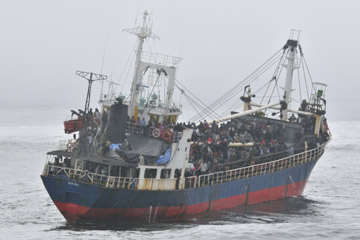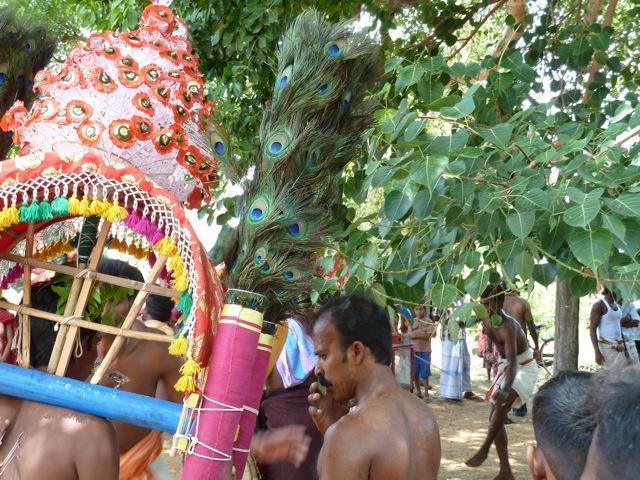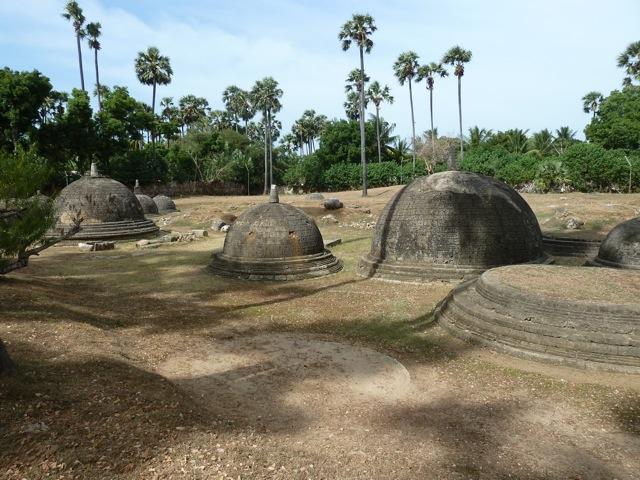Toronto Star Editorial -
Sunday August 15, 2010 -
Sri Lanka’s
telling exodus

Canada doesn’t have a Tamil
“problem,” whatever critics of our refugee system may say about
the arrival here of the cargo freighter MV Sun Sea with some 500
asylum-seekers. We processed 34,000 refugee claims last year;
these arrivals won’t overtax the system. It is Sri Lanka that has
a problem. President Mahinda Rajapaksa’s triumphalist government
has failed to make the country’s large Tamil minority feel secure
after crushing the Tiger insurgency last year. Until he does,
people will continue to flee.
That’s a message Prime Minister Stephen Harper’s government should
drive home, as the United Nations, the United States and India
have done. Sri Lanka didn’t win the war on its own. India’s
political support for Colombo and its naval blockade weakened the
Tigers. So did U.S. and Canadian moves to cut off Tiger funding.
Canada is anything but “soft” on terror, nor should we be. Any
Tiger leaders on the ship shouldn’t expect asylum. Still, our help
presupposed a fair deal for Tamils when the war ended.
Now Tamils are fleeing abroad in desperation. So it was a bit much
to hear Sri Lankan High Commissioner Chitranganee Wagiswara urging
Ottawa to turn away the Sun Sea, with its women and children, to
prevent Tigers from regrouping here. If Sri Lanka’s Sinhalese
majority of 17 million were making the minority 4 million Tamils
feel less threatened, fewer would be regrouping anywhere.
Rajapaksa once spoke of giving Tamil regions “substantive
provincial autonomy” within a unitary state. He talked of creating
a kind of senate to enforce minority rights and of recruiting more
Tamils to the bureaucracy and military. But the Tamils are still
waiting.
“Most people in Sri Lanka are not particularly interested in a
political solution,” says Jehan Perera of the country’s National
Peace Council. “To the great majority, the end of the (Tigers) has
meant the end of terrorism and the end of what troubled them and
the country.”
Indeed, instead of showing magnanimity in victory and delivering
reform, the Sri Lankan authorities have chosen to rebuff a UN
probe into war crimes on both sides and to focus more on economic
rebuilding than on devolution. Reconciliation is a distant
prospect.
Rather than amplify Sri Lanka’s self-serving rhetoric about
“terrorists” probing Canada’s defences, the Harper government
should use the political capital it has built up to press for
justice for Tamils. That, more than anything, would put the people
smugglers out of business.
Courtsy:
http://www.thestar.com/opinion/editorials/article/847832--sri-lanka-s-telling-exodus
http://transcurrents.com
Sinhala
nationalist mind set seems incapable of comprehending what Tamils
are articulating Revisiting Jaffna BY Dushy Ranetunge
 Jaffna remains one of Sri Lanka’s most beautiful cities with the
lagoons, the long roads across the sea connecting its many
islands, stunning beaches, the calm lagoon like sea, many
beautiful Hindu temples, the many excellent centres of education,
the Portuguese fort and its gentle peoples who are to a great
extent bilingual and perhaps the most hardworking and productive
in Sri Lanka.
Jaffna remains one of Sri Lanka’s most beautiful cities with the
lagoons, the long roads across the sea connecting its many
islands, stunning beaches, the calm lagoon like sea, many
beautiful Hindu temples, the many excellent centres of education,
the Portuguese fort and its gentle peoples who are to a great
extent bilingual and perhaps the most hardworking and productive
in Sri Lanka.
The bazaar remains open into the late evening and large numbers of
bicycles clog the streets as its peoples go about their business.
At the commencement of hostilities Jaffna was Sri Lanka’s second
largest city.
Distances between towns in kilometres marked on street signs are
displayed to two decimal places, highlighting the exacting mindset
of the Jaffna citizen.
In addition Jaffna has some of the best food in the region. Their
Jaffna crab curry puts Australia’s mud crab of Port Douglas and
Melbourne to shame.
After clearing the checkpoint north of Omanthai, we witnessed the
reconstruction of the old railroad destroyed during the war. The
A9 highway from Omanthai until Elephant Pass is dominated by
predominantly Sinhalese soldiers, who even operate the small
restaurants by the roadside. This military presence seems
overwhelming and stifling.
The check point north of Omanthai, the long distance from Omanthai
to Elephant pass, the different culture, language, religion and
cuisine at the other end in the Jaffna peninsula gave the
perception of visiting a different country. This was felt by
everyone in the three SUV’s who made up a party of 12 who were all
Sinhalese.
They also without exception viewed the many roadside bunkers in
the Jaffna Peninsula and soldiers guarding most junctions as
creating a perception of an army of occupation.
The politeness, general attitude and professionalism of the
predominantly Sinhalese soldiers manning bunkers and checkpoints
were impressive. But however efficient, friendly and helpful they
are, a predominantly Sinhalese force manning bunkers and standing
at every street corner in Jaffna will be viewed with hostility by
the Tamil population similar to how a Sinhalese population would
perceive a Tamil army setting up bunkers and standing in every
street corner in Hambanthota, Galle or Matara.
The soldiers themselves told us on several occasions that some in
the local population look at them with a “vapara” eye.
To the Sinhalese visitor or soldier, the average Jaffna Tamil
would say that everything is fine and that they are happy and want
nothing more than peace, as repeated by President Mahinda
Rajapakse when pressed on a political resolution.
But scratch the surface and once they feel that they can trust
you, a different perception could be unearthed, often repeated by
India and the Western democracies. An elderly Jaffna Tamil man who
owns a petrol station on KKS road told this reporter last Monday,
that Tamils want equality as articulated by Chelvanayagam. When I
inquired if they will be happy with provincial councils, he said
that they don’t work.
Our visit to Jaffna exposed and confirmed that all the conditions
and discontent that led to the Tamil rebellion are still present
today. The only ingredient that is lacking is the combustion of
anti-Tamil riots such as in 1956, 1958, 1977, 1981, and 1983.
The Sinhala nationalist mind set seems incapable of comprehending
what the Tamils are articulating.
The Tamils object to the “Sinhalisation” of Tamil areas. The
Sinhalese nationalists say that if Tamils can live in Wellawatta,
Sinhalese should be settled in the North and East.
The Sinhalese nationalist mind fails to comprehend the subtle
difference between a Tamil deciding to live in Wellawatta and the
state settling Sinhalese and building Buddhist temples in Tamil
areas. One is a demonstration of citizen’s right to live anywhere
in the republic and the other can be interpreted as the dominant
tribe having seized control of the republic, abusing the republics
resources for the benefit and perpetuation of the hegemony of the
dominant tribe.
For example, in order to quell the southern JVP rebellion of 1971
and 1989, would the state have settled Tamils and Muslims in Galle
and Matara and help build mosques and Hindu kovils in Galle and
Matara to subdue the rebellious Sinhalese, to the same extent that
they are doing in the North and East?
We visited Nagadipa in Nainathivu, Casuarina Beach in Karainagar
(Karaithivu), Nalour Kovil, the Nilavarai deep black bottomless
well in Nawathkiri, the ancient Buddhist ruins of Kantharodai,
Point Pedro, KKS, Velvettithurai, Keerimalai beach and Kovil,
Elephant Pass, Killinochchi, Mullaithivu, Iranamadu Tank, LTTE
airfield, Kokillai, and Welioya.
The Nalour Kandasamy Kovil, one of the largest and venerated Hindu
Kovil’s in the North was constructed by Chempaha Perumal known to
the Sinhalese as Sapumal Kumaraya. His name is repeated daily in
the Kattiyam as “Sri Sangabo Buvanekabahu”. The artwork in this
temple reflects southern influence.
We visited the war memorials in Kilinochchi and Elephant Pass, and
noticed the mention of Gothabaya Rajapakse and Mahinda Rajapakse
in the memorial plaque. Soldiers were unhappy that there is no
mention of General Sarath Fonseka on these two memorials. Some
soldiers told us that Sinhalese visitors from the South had also
commented on this point.
Irrespective of Fonseka’s Political shortcomings, the
acknowledgement of his contribution to the war effort is common
decency and the attempt to erase his name reflects negatively on
the Rajapakse’s integrity.
There are large numbers of Sinhalese visiting the North at present
and this is having its impact on the local population. Young
Sinhalese male visitors are harassing females with various
unwarranted and disrespectful comments. We heard these in Jaffna
town as well as at Casuarina beach, which is littered with plastic
bottles and bags. We saw one group standing around in the shallow
sea with a bottle of liquor in the centre and eating processed
crisps like food from a plastic wrapper which was allowed to float
away after they had finished consuming it.
 The Kantarodai ancient Buddhist remains, which was not desecrated
by the LTTE, and which I had visited on several occasions
previously during and before the conflict, has been desecrated by
recent Sinhalese visitors who had written their phone numbers and
names on the ancient stupas. This has now been cleaned, but the
marks are still visible. During my previous visits, I walked
freely around the many stupas at Kantharodai, but now its been
cordoned off and the soldiers guarding it stated that the new
restrictions are in place because the site had been desecrated by
recent visitors from the south.
The Kantarodai ancient Buddhist remains, which was not desecrated
by the LTTE, and which I had visited on several occasions
previously during and before the conflict, has been desecrated by
recent Sinhalese visitors who had written their phone numbers and
names on the ancient stupas. This has now been cleaned, but the
marks are still visible. During my previous visits, I walked
freely around the many stupas at Kantharodai, but now its been
cordoned off and the soldiers guarding it stated that the new
restrictions are in place because the site had been desecrated by
recent visitors from the south.
We visited the home of a poor Jaffna Tamil shopkeeper who treated
us with vadai, bananas and tea. Their generosity and friendliness
was no different to what we had experienced in the South.
One of the first things we saw on Sunday as we drove into Jaffna
was Cavady dancing where men had pierced the middle of their back
with hooks. Everyone in the vehicles were excited with the
spectacle, but failed to notice something significant in the
setting in which the religious ritual was taking place.
It was under an ancient Bo-tree. Jaffna has many Bo Trees and many
of them have a little shrine built at the base of the tree,
normally a shrine for Ganesha.
Generations of Sri Lankans have grown up being conditioned that
the Sinhalese were the sons of the soil and that the Tamils were
South Indian invaders who had invaded much later dislodging the
Sinhalese in the North and occupying their lands. Similar to the
Serbian view of Kosovo, the Sinhalese regard the North as Sinhala
Buddhist land over-run by South Indian Invaders.
This view has more recently been dismissed by historians, as there
is no evidence of large scale population displacement from the
North.
In areas where the Sinhalese were displaced such as in the North
Central Province, place names have been replaced by new Tamil
names, but in Jaffna there are to the present day over a thousand
“Sinhalese” place names, which survive in a Tamil garb, such as
Aliyawala(i), kodigama(m), Weligama(m) etc.
This indicates that rather than wholesale displacement of the
population, there has been a gradual Tamilisation. Recent DNA
testing has also indicated that Sri Lankan Tamils are genetically
closer to the Sinhalese than they are to South Indian Tamils.
All this and other evidence has led historians to reject the old
theories and advocate that what has taken place in Jaffna is
language and cultural replacement.
The same way that Sri Lankans in Colombo and the Western provinces
have undergone language and cultural replacement by acquiring the
English language, dress, cultural behaviour and Christianity in
some instance, because of their contact with Western colonialism
from 1505 onwards, Sri Lankans in the North have undergone
language and cultural replacement by acquiring the Tamil language,
dress, Hinduism and cultural behaviour because of their contact
with South Indian colonialism from 992AD onwards.
The place names, the numerous Bo-Trees and ancient Buddhist
remains indicate that the people of Jaffna were Buddhists from
about 400BC till approximately 992AD, but despite them acquiring
the Tamil language, culture and Hinduism, even today, they
continue to perform some of their religious rituals under Bo-trees
as they did so many generations ago.
http://transcurrents.com/tc/2010/08/sinhala_nationalist_mind_set_s.html#more
Sent by visagaperumal_vasanthan@yahoo.co.uk

